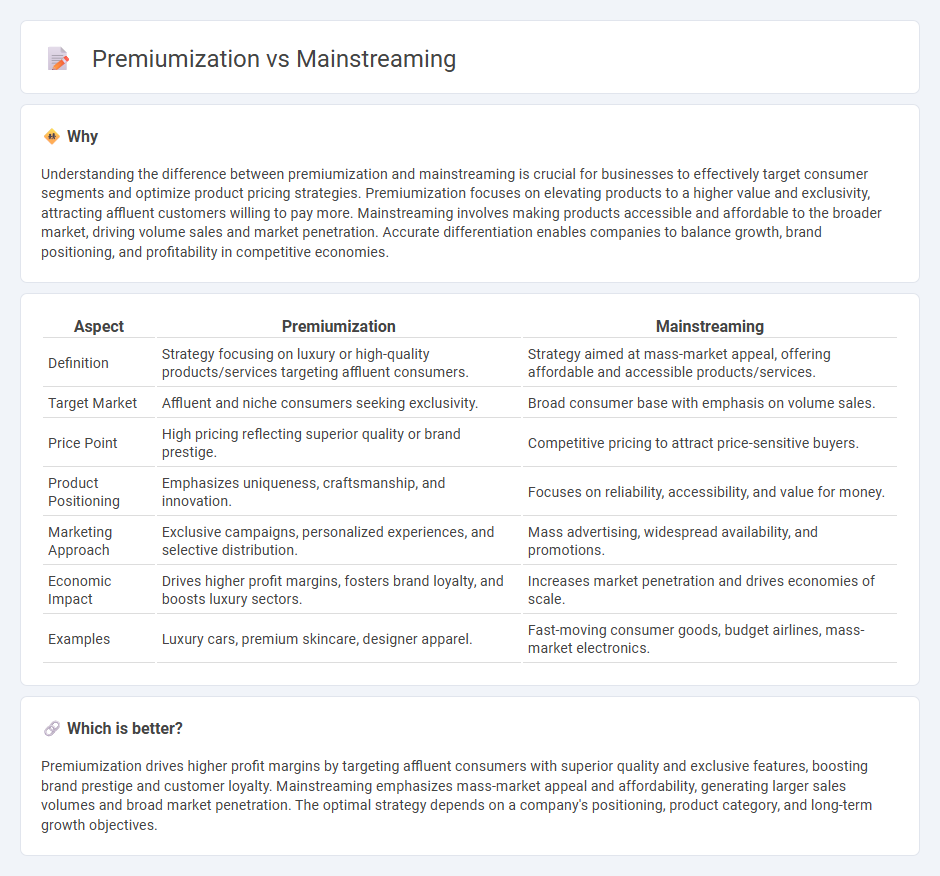
Premiumization drives higher consumer spending by offering exclusive, high-quality products that enhance brand value and customer loyalty, while mainstreaming focuses on scaling accessibility and affordability to capture broader market share. The balance between premiumization and mainstreaming influences pricing strategies, product development, and consumer behavior trends across various industries. Explore how these economic dynamics shape competitive advantages and market growth.
Why it is important
Understanding the difference between premiumization and mainstreaming is crucial for businesses to effectively target consumer segments and optimize product pricing strategies. Premiumization focuses on elevating products to a higher value and exclusivity, attracting affluent customers willing to pay more. Mainstreaming involves making products accessible and affordable to the broader market, driving volume sales and market penetration. Accurate differentiation enables companies to balance growth, brand positioning, and profitability in competitive economies.
Comparison Table
| Aspect | Premiumization | Mainstreaming |
|---|---|---|
| Definition | Strategy focusing on luxury or high-quality products/services targeting affluent consumers. | Strategy aimed at mass-market appeal, offering affordable and accessible products/services. |
| Target Market | Affluent and niche consumers seeking exclusivity. | Broad consumer base with emphasis on volume sales. |
| Price Point | High pricing reflecting superior quality or brand prestige. | Competitive pricing to attract price-sensitive buyers. |
| Product Positioning | Emphasizes uniqueness, craftsmanship, and innovation. | Focuses on reliability, accessibility, and value for money. |
| Marketing Approach | Exclusive campaigns, personalized experiences, and selective distribution. | Mass advertising, widespread availability, and promotions. |
| Economic Impact | Drives higher profit margins, fosters brand loyalty, and boosts luxury sectors. | Increases market penetration and drives economies of scale. |
| Examples | Luxury cars, premium skincare, designer apparel. | Fast-moving consumer goods, budget airlines, mass-market electronics. |
Which is better?
Premiumization drives higher profit margins by targeting affluent consumers with superior quality and exclusive features, boosting brand prestige and customer loyalty. Mainstreaming emphasizes mass-market appeal and affordability, generating larger sales volumes and broad market penetration. The optimal strategy depends on a company's positioning, product category, and long-term growth objectives.
Connection
Premiumization drives consumer demand toward higher-quality, luxury products, while mainstreaming expands these premium offerings into broader markets, making them more accessible and affordable. This interconnected process enhances overall economic growth by increasing product diversity and stimulating consumption across different income segments. Businesses leverage premiumization to create value and mainstreaming to scale, optimizing profitability and market reach simultaneously.
Key Terms
Market Segmentation
Market segmentation differentiates mainstreaming by targeting broad consumer groups with affordable, accessible products, while premiumization focuses on niche markets seeking high-quality, exclusive experiences. Mainstream brands emphasize cost-efficiency and volume sales, whereas premium brands prioritize superior materials, innovation, and brand prestige. Explore the impact of these strategies on consumer behavior and market trends to optimize your approach.
Value Proposition
Mainstreaming emphasizes broad accessibility and competitive pricing to attract a wide consumer base, while premiumization focuses on unique, high-quality features that justify a higher price point and create brand prestige. Value proposition in mainstreaming revolves around affordability and convenience, whereas premiumization highlights exclusivity, superior craftsmanship, and enhanced user experience. Explore how businesses balance these strategies to maximize market reach and customer loyalty.
Consumer Perception
Consumer perception plays a crucial role in differentiating mainstreaming and premiumization strategies, where mainstreaming emphasizes affordability and accessibility, appealing to price-sensitive shoppers, while premiumization centers on quality, exclusivity, and brand prestige that attract discerning buyers seeking superior experiences. Market data indicate that premium products often command higher profit margins and loyalty due to perceived value, whereas mainstream products target broader market shares through volume sales. Discover more about how consumer insights can refine your brand strategy for optimal market positioning.
Source and External Links
What is Mainstreaming in Special Education? - Mainstreaming involves placing a student with a disability in a general education classroom with necessary accommodations and support to provide equal access to instruction and social participation alongside peers.
Mainstreaming | Cal State LA - Mainstreaming is the practice of educating students with special needs in regular classes during specific time periods based on their individual skills, aiming to place children in the least restrictive environment.
Mainstreaming in the Public Schools | EBSCO Research Starters - Mainstreaming is integrating students with disabilities into general education classrooms while providing tailored support, mandated by IDEA to ensure education in the least restrictive environment and promote equal opportunities.
 dowidth.com
dowidth.com